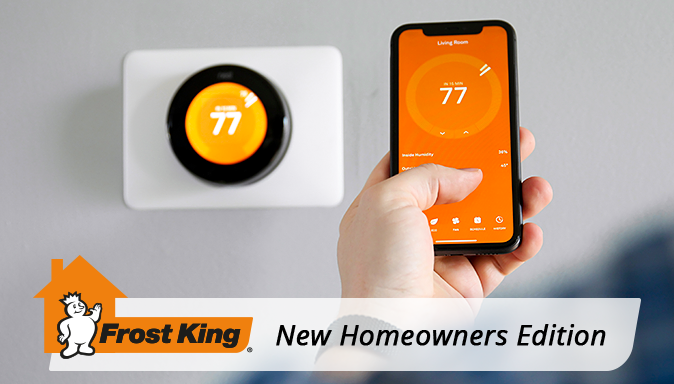If one of your New Year’s resolutions was to be smarter about money in 2022, we’ve got some smart tips and tricks that can help you save cash while making your home more energy efficient.
1. Switch light bulbs. According to Energy Star, replacing the bulbs in your five most frequently used light fixtures with energy-saving LED or CFL bulbs can save $70 a year in energy costs. Plus, they last up to 10 times longer than standard bulbs so you’ll spend less money on replacement bulbs down the road. And another way to save money on lighting without spending a dime? Turn the lights off whenever you leave a room.
2. Fix leaky windows. Old windows can be a leading source of energy loss in your home, but new, energy efficient windows can cost anywhere from $200-$1,800 per window. Fortunately, there’s a less expensive way to stop drafts that can save 30-40% on your heating bill: window film kits that shrink clear, tight, and wrinkle free to block out drafts and keep warm air inside. Plus, they’re a cinch to install: check out our video for a quick how-to. You should also caulk and weatherstrip around windows to fill any gaps that let in cold air:
3. Stop drafts from outlets and switches. Conservation Mart estimates that 2 to 5 percent of all residential heat loss comes from electrical outlets and wall switches on exterior walls. Stop this heat loss by installing inexpensive outlet sealers that fit between the face plate and the wall.
4. Shut the door on drafts. Standard doors have a gap of about 1/8” between the bottom of the door and the threshold. This gap is necessary for the door to easily swing open and closed—but it means that air can easily seep in through the gap. That’s why all exterior doors should have a door sweep—a long strip of metal that holds a sealing material—installed. Watch this video for simple step-by-step installation instructions. Seal gaps around the door and the frame with caulk and weatherstripping for even more savings:
5. Install a programmable or smart thermostat. If you’re still using a manual thermostat, you are missing out on big savings! A programmable thermostat can save about $180 on annual energy costs. With most programmable thermostats, you can set multiple temperature changes throughout the day for each day of the week—so you can easily adjust the temperature to be lower when you’re away from home or sleeping, and higher when you’re at home. A smart thermostat goes a step further by actually learning from your behavior to adjust the temperature to make your home more comfortable. It can also provide energy reports and will notify you when it’s time to replace the air filter.
6. Save on Hot Water. The gold standard for saving energy on hot water are tankless water heaters, which only heat water when you need it—but these tankless water heaters are significantly more expensive than traditional tank water heaters. If you have an older, traditional water heater, you can improve its efficiency—and save more than $30 per year—by setting it to 120 degrees F and wrapping it with a Water Heater Insulation Blanket. Watch this video (link to the video at the bottom of this page: https://www.frostking.com/products/pipe-duct-insulation/water-heater-insulation-blanket) for installation instructions. You can also insulate the pipes coming out of your water heater to stop heat loss. Our flexible Rubber Tubular Pipe Insulation tubes are pre-slit and easy to install. This video shows you how:
7. Seal those Ducts. Forced-air heating systems use ducts to distribute heated air throughout the home—but according to Energy Star, 20 to 30 percent of the air you paid good money to heat is lost through leaks, holes, and poorly connected ducts. Sealing exposed ductwork in your basement is a good way to stop some of the leaks and save on heating costs. Our Foam and Foil Duct Insulation can be wrapped around ducts and taped securely in place to reduce air leaks—and in the summer, it will save you money on air conditioning, too.
